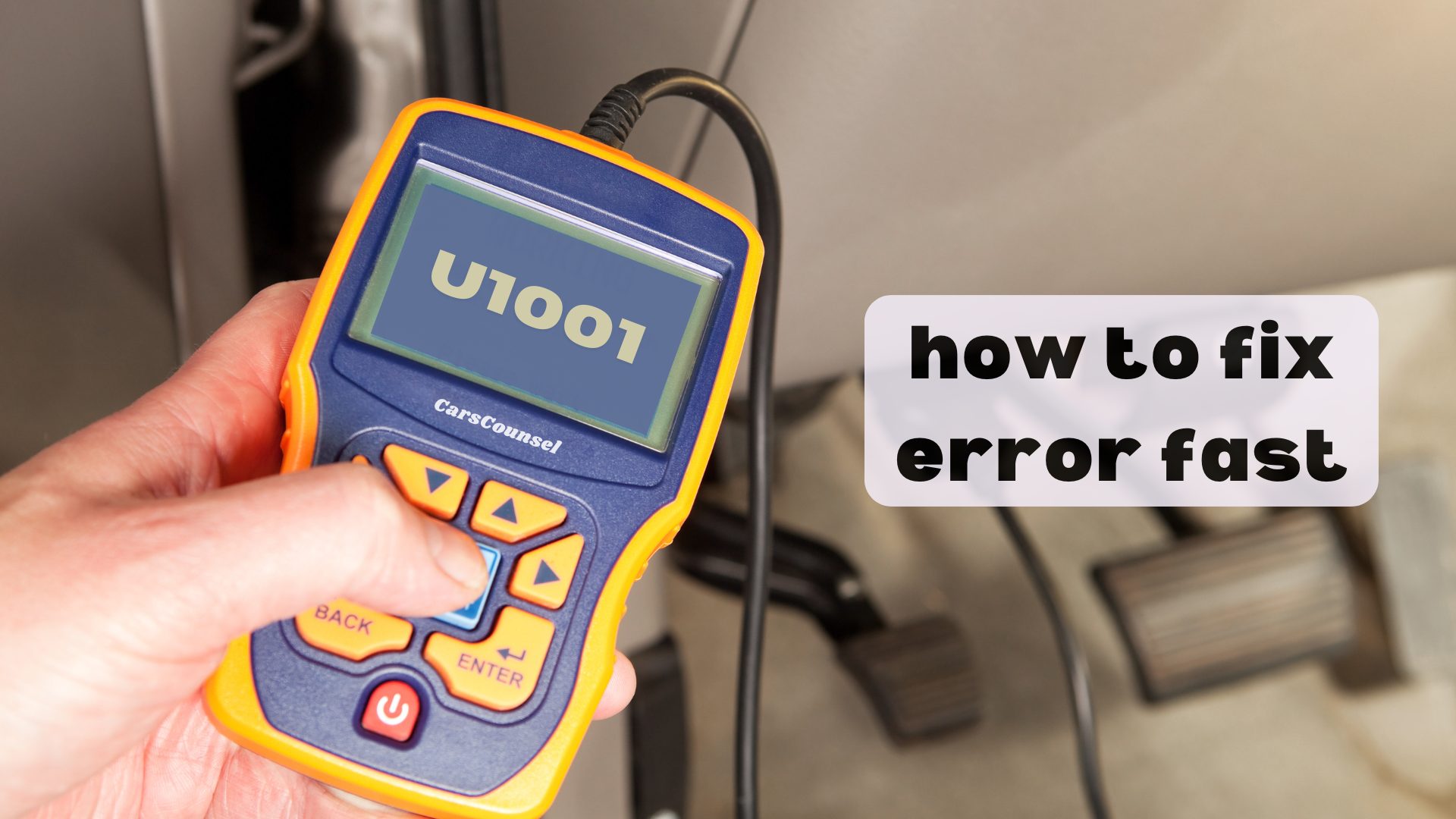The U1001 code is a communication error that can mess with multiple systems in your car, causing annoying performance issues.
To fix it quickly, use an OBD-II scanner to get an accurate diagnosis. Then, check the wiring and connectors for any damage or corrosion, as these are common culprits.
Make sure your Engine Control Module (ECM) and Transmission Control Module (TCM) are compatible. Once you find and fix the problems, clearing the error codes should get your car back to running smoothly.
To prevent this from happening again, there’s more to look into.

Quick Navigation
Key Takeaways
- Use a car diagnostic tool to read and clear the U1001 error code.
- Check and fix any damaged or corroded wires and connectors.
- Make sure the Engine Control Module (ECM) and Transmission Control Module (TCM) have the latest software updates.
- Test sensors and communication modules to ensure they are working correctly.
Understanding U1001 Code
The U1001 code means there’s a communication problem between your car’s Engine Control Module (ECM) and Transmission Control Module (TCM). This issue can lead to poor performance and even engine stalling.
To fix it, you’ll need an OBD-II scanner to get the code. Look for damaged or rusty wires and connectors, as these are often the problem.
Check the CAN bus network for any issues and make sure all sensors and modules are working right. Fixing these problems quickly can help avoid bigger issues and expensive repairs, keeping your car running well.
Why U1001 Matters
Paying attention to the U1001 code is really important because it affects how well your car’s control systems talk to each other. This communication is crucial for your car to run smoothly and stay safe.
Ignoring this code can cause some serious problems, like:
- Worse Gas Mileage: If the engine and transmission aren’t communicating well, your car won’t run as efficiently.
- Engine Might Stall: Ongoing communication issues can make your engine stall out of the blue.
- Higher Repair Bills: Fixing the problem early can save you from expensive repairs later on.
It’s important to understand and deal with U1001 quickly to keep your car in good shape and ensure your safety.
Common U1001 Symptoms
If you see dashboard warning lights and your car is acting strangely, you might have a U1001 code.
Common signs include the car having trouble shifting gears smoothly, which can make your fuel costs go up. You might also notice that systems like ABS and traction control aren’t working right.
Your car might have trouble starting or could even stall. You’ll also see worse gas mileage because the Engine Control Module (ECM) and Transmission Control Module (TCM) aren’t talking to each other properly.
Catching these symptoms early can help you fix the U1001 code and keep your car running well.
Recognizing Dashboard Alerts
When you see a U1001 code, it’s important to recognize dashboard alerts to spot communication problems between the ECM and TCM. Keep an eye on these dashboard lights, as they give you crucial information:
- Check Engine Light: This is the most common sign that something is wrong with your car’s communication system.
- Transmission Warning Light: If this light comes on, it could mean there are issues with the TCM, which can affect gear shifting and overall transmission performance.
- ABS/Traction Control Light: Communication errors can also impact these systems, causing dashboard alerts to indicate a problem.
Addressing these alerts quickly can prevent more issues and ensure your car runs smoothly.
Causes of U1001 Code
The U1001 code often shows up because of faulty wiring, bad connections, or damaged sensors.
Wiring is crucial; if it’s damaged or corroded, it can mess up the communication between the ECM and TCM. Loose or corroded connectors make the problem worse by causing poor connections that block proper data flow.
Damaged sensors can also send wrong information, triggering the U1001 code. Compatibility between different modules matters too.
Software issues, like bad updates in the ECM or TCM, can cause communication failures. Environmental factors such as moisture and extreme temperatures can further damage wiring and components.
To avoid the U1001 code, it’s important to ensure all modules and wiring are in good shape.
Diagnosing U1001 Issues
To figure out U1001 problems, start by using an OBD-II scanner to find and understand the error code. This will help you identify issues with module communication.
- Check Wiring and Connectors: Look for damaged or rusty wires and loose connections using diagnostic tools. Make sure all connections are tight and secure.
- Test Sensors and Modules: Use a multimeter to check if sensors are working and if modules are communicating properly. Faulty sensors or modules can mess up the CAN bus network.
- Check Battery Voltage and Grounds: Make sure the battery voltage is correct and the grounding is solid. Use accurate diagnostic tools to test these, as they’re crucial for reliable module communication.
Using an OBD-II Scanner
Start by plugging your OBD-II scanner into the car’s diagnostic port, which is usually under the dashboard.
Make sure the ignition is on, but the engine is off.
It’s important to know some basics about OBD-II because it helps you read and understand diagnostic trouble codes (DTCs) like U1001.
Modern scanners have cool features like live data streaming, freeze frame data, and the ability to clear codes.
Use the scanner’s menu to find and read the error codes.
When you see U1001, write down the details for further investigation.
You can also use the scanner to check the communication signals between the Engine Control Module (ECM) and the Transmission Control Module (TCM) to find out where the communication problem is happening.
This first step is crucial for figuring out what’s wrong accurately.
Inspecting Wiring and Connectors
Begin by checking the vehicle’s wiring and connectors for any signs of damage, corrosion, or loose connections that could disrupt communication between the ECM and TCM. Keeping the wiring and connectors in good condition is crucial to avoid the U1001 code.
Follow these steps:
- Check the Wiring: Look for any frayed, cut, or exposed wires. Damaged wiring can seriously affect communication.
- Inspect the Connectors: Make sure connectors are tight and free from corrosion. Loose or corroded connectors can cause erratic signals.
- Test Continuity: Use a multimeter to check the continuity of wires and connectors, ensuring there are no breaks or faults in the circuit.
Keeping the wiring and connectors in good shape is important for fixing U1001 errors effectively.
Fixing Communication Errors
After checking the wiring and connectors, the next step is to fix any communication issues between the ECM and TCM to resolve the U1001 code.
First, make sure that these modules can talk to each other. Look for any software updates for both the ECM and TCM to ensure they’ve the latest versions.
If updating the software doesn’t fix the problem, you might need to reprogram or replace the modules. Make sure all the modules work well together to avoid more communication problems.
Once you’ve made the necessary fixes, clear the error codes and reset the system.
Preventing Future Errors
Keeping your vehicle’s wiring and connectors in good shape is crucial to avoid the U1001 error code. By following a regular maintenance routine, you can reduce the chances of having issues with faulty wiring and bad connections.
Here are three simple steps to keep your vehicle running smoothly:
- Inspect regularly: Look for any signs of wear, rust, or damage in the wiring and connectors.
- Protect the connectors: Use dielectric grease on connectors to keep out moisture and prevent rust.
- Update software: Make sure your vehicle’s ECM and TCM software are up-to-date to prevent glitches and communication problems.
More OBD-II Codes
Frequently Asked Questions
Can U1001 Code Affect Multiple Vehicles in a Fleet Simultaneously?
Yes, the U1001 code can affect multiple vehicles in a fleet simultaneously. To keep things running smoothly, it’s important to regularly check the vehicles for any communication problems between the Engine Control Module (ECM) and the Transmission Control Module (TCM). This helps prevent big disruptions in operations.
How Long Does It Usually Take to Diagnose U1001 Code?
Figuring out the U1001 code usually takes around 1-2 hours. You’ll need an OBD-II scanner to read the code, inspect the wiring, and look for signs like transmission slipping and warning lights on the dashboard to find the problem.
Are There Any DIY Fixes for U1001 Code?
To address the U1001 code issues, you can try some DIY fixes. Look for common problems like rusty connectors and broken wires. Use an OBD-II scanner to start troubleshooting, check the wiring, and make sure all sensors and connections are secure.
What Tools Are Needed to Fix the U1001 Code?
To fix the U1001 code, you’ll need some basic tools like an OBD-II scanner and a multimeter. You might also need a wiring repair kit, some connectors, and possibly tools to reprogram modules for accurate diagnostics and repairs.
Can a U1001 Code Trigger Emission Test Failures?
Imagine your car having trouble communicating with its own systems; a U1001 code can indeed cause it to fail an emissions test. It messes with how the car talks to different parts, which can affect emissions. To fix it, you need to properly diagnose and address the root problem.
Conclusion
You’ve got the steps to fix the U1001 code quickly.
Imagine navigating through the car’s wiring like an expert sailor in rough waters. With your OBD-II scanner as your guide, you’ll spot and fix communication errors, making sure your vehicle runs well.
By checking connectors and updating software, you’re not just fixing a problem—you’re preventing future issues.
Follow these steps, and your engine will run smoothly again.

